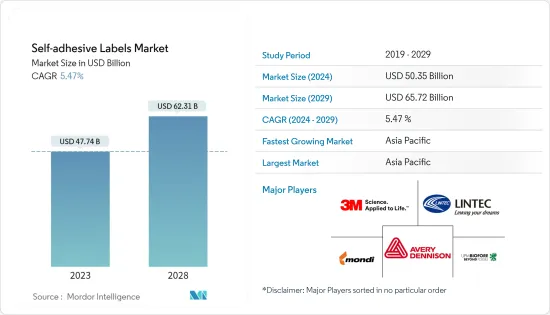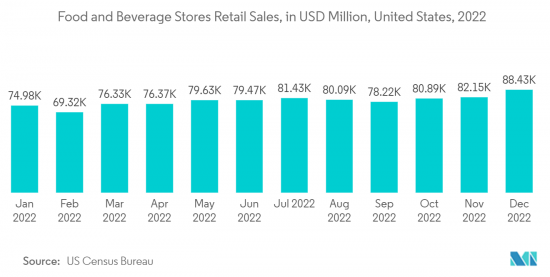 |
市場調查報告書
商品編碼
1404400
自黏標籤:市場佔有率分析、產業趨勢與統計、2024-2029 年成長預測Self-adhesive Labels - Market Share Analysis, Industry Trends & Statistics, Growth Forecasts 2024 - 2029 |
||||||
※ 本網頁內容可能與最新版本有所差異。詳細情況請與我們聯繫。
不乾膠標籤市場規模預計到2024年為503.5億美元,預計到2029年將達到657.2億美元,在預測期內(2024-2029年)複合年成長率預計為5.47%。

COVID-19 的爆發以及隨後的全國封鎖、製造活動和供應鏈的中斷以及生產停頓對 2020 年的市場產生了負面影響。然而,情況在 2021 年開始改善,恢復了預測期內的市場成長軌跡。
主要亮點
- 快速成長的電子商務行業和不斷成長的食品和飲料消費預計將推動市場需求。
- 相反,不斷增加的政府法規和無襯標籤等替代品的出現預計將阻礙市場成長。
- 由於轉向永續實踐,對生物基自黏劑的需求不斷增加,這將為所研究的市場提供機會。
- 亞太地區佔有很大佔有率,預計在預測期內將繼續佔據主導地位。
不乾膠標籤市場趨勢
食品和飲料行業的需求增加
- 自黏標籤因改善食品和飲料包裝品牌的美觀而聞名。包裝和標籤在產品銷售中發揮著至關重要的作用,因為它有助於吸引消費者的注意。負責人主要使用標籤來說服潛在消費者購買產品。標籤傳達了包裝或產品應如何使用、運輸、回收和處置。
- 標籤提供食品和飲料行業的成分資訊、產品標識和警告。自黏標籤製造商必須遵守法律要求,以確保黏合劑不會影響食品成分。
- 此外,預計到年終,全球食品包裝市場將達到約3,620億美元,到2027年將達到4,636.5億美元。因此,未來幾年食品包裝市場的成長可能會增加對不乾膠標籤的需求。
- 根據美國商務部的數據,2023 年 1 月零售和食品服務商店總銷售額為 782.7 億美元。而 2022 年 1 月,這一數字為 749.8 億美元。大幅成長約4.39%,預計還會進一步成長。
- 此外,各種食品加工公司正在為其包裝食品業務投資新工廠和產能擴張。根據生產連結獎勵(PLI)計劃,印度政府已收到 60 家加工食品公司的投資提案,包括印度斯坦聯合利華、Amul、雀巢、Dabur、ITC、Parle 和 Britannia。
- 因此,預計上述因素將在預測期內增加對不乾膠標籤的需求。

亞太地區主導市場
- 亞太地區主導市場,預計在預測期內將顯著成長。中國、印度、日本和韓國等國家不斷發展的包裝、電子和個人護理行業正在增加不乾膠標籤的消費。
- 2022年,中國個人護理和化妝品出口總額為56.3億美元,2021年為48.5億美元。與前一年同期比較成長16.08%,預計未來還會進一步成長。
- 中國是最大的電子產品生產中心。智慧型手機、電視和其他個人設備等電子產品在電子產品中成長最快。該國滿足國內對電子產品的需求,並向其他國家出口電子產品。隨著中產階級可支配收入的增加,對電子產品的需求預計將增加。
- 據ZEVI稱,2021年亞洲電子市場規模達3.11兆歐元(3.674兆美元),成長10%。預計2022年市場將成長13%,2023年成長率為7%。中國市場是世界上最大的市場,比工業國家市場的總合還要大。此外,中國電子產業預計2022年將成長14%,2023年將成長8%。
- 不乾膠標籤廣泛用於進出口各國藥品、醫療設備的包裝。印度政府預計,到2030年,印度醫藥產業市場規模預計將達到1,300億美元。印度向200多個國家供應藥品,未來可能會繼續這樣做。
- 在經濟成長、人口紅利和電子商務成長的推動下,印度第五大包裝產業正在經歷強勁成長。例如,2022 年 1 月,Flipkart 宣布將擴大雜貨服務,為印度 1800 個城市提供服務。 2022 年 6 月,亞馬遜印度公司將與曼尼普爾邦政府公司曼尼普爾手織機和手工藝品發展有限公司 (MHHDCL) 簽署合作備忘錄,以支持該州工匠和編織者的發展。
- 這些因素可能會在預測期內推動受調查市場的需求。
不乾膠標籤行業概況
研究目標市場是細分的。市場主要企業包括(排名不分先後)3M、Avery Dennison Corporation、UPM、Mondi 和 LINTEC Corporation。
其他福利:
- Excel 格式的市場預測 (ME) 表
- 3 個月的分析師支持
目錄
第1章簡介
- 調查先決條件
- 調查範圍
第2章調查方法
第3章執行摘要
第4章市場動態
- 促進因素
- 快速發展的電子商務產業
- 食品和飲料業對加工食品的需求增加
- 其他司機
- 抑制因素
- 加強政府監管
- 其他阻礙因素
- 產業價值鏈分析
- 波特五力分析
- 供應商的議價能力
- 消費者議價能力
- 新進入者的威脅
- 替代品的威脅
- 競爭程度
第5章市場區隔(以金額為準的市場規模)
- 黏劑型
- 熱熔膠
- 乳液丙烯酸
- 溶劑
- 面材
- 紙
- 塑膠
- 聚丙烯
- 聚酯纖維
- 乙烯基塑膠
- 其他塑膠
- 目的
- 食品和飲料
- 藥品
- 物流/運輸
- 個人護理
- 耐久性消費品
- 其他用途
- 地區
- 亞太地區
- 中國
- 印度
- 日本
- 韓國
- 其他亞太地區
- 北美洲
- 美國
- 加拿大
- 墨西哥
- 歐洲
- 德國
- 英國
- 法國
- 義大利
- 其他歐洲國家
- 南美洲
- 巴西
- 阿根廷
- 南美洲其他地區
- 中東/非洲
- 南非
- 沙烏地阿拉伯
- 其他中東和非洲
- 亞太地區
第6章競爭形勢
- 併購、合資、聯盟、協議
- 市場佔有率(%)**/排名分析
- 主要企業策略
- 公司簡介
- 3M
- Asteria Group
- Avery Dennison Corporation
- CPC Haferkamp GmbH & Co. KG
- Fuji Seal International, Inc.
- HB Fuller Company
- HERMA
- LECTA
- LINTEC Corporation
- Mondi
- Optimum Group
- Symbio, Inc.
- Thai KK Group
- UPM
第7章 市場機會及未來趨勢
- 將焦點轉向生物基不乾膠標籤
- 其他機會

The Self-adhesive Labels Market size is estimated at USD 50.35 billion in 2024, and is expected to reach USD 65.72 billion by 2029, growing at a CAGR of 5.47% during the forecast period (2024-2029).
The COVID-19 outbreak and the subsequent nationwide lockdowns, disruption in manufacturing activities and supply chains, and production halts negatively impacted the market in 2020. However, the conditions started recovering in 2021, restoring the market's growth trajectory for the forecast period.
Key Highlights
- The rapidly growing e-commerce industry and increased consumption of food and beverage products will likely drive the market demand.
- Conversely, increasing government regulations and the availability of substitutes like linerless labels will likely hinder market growth.
- The increasing demand for bio-based self-adhesives with a shift to sustainable practices will act as an opportunity for the market studied.
- Asia-Pacific dominated the market with a significant share and is expected to continue its dominance during the forecast period.
Self Adhesive Labels Market Trends
Increasing Demand from the Food and Beverage Industry
- Self-adhesive labels are known to improve the aesthetic characteristics of food and beverage packaging brands. Packaging and labeling play an essential role in the sale of products, as they help grab consumers' attention. Marketers mainly use them to encourage potential consumers to purchase the product. Labels communicate how to use, transport, recycle, and/or dispose of the package or product.
- Labeling provides ingredient information, product identification, and cautionary notifications in the food and beverage sector. Self-adhesive label manufacturers must comply with the legal requirements to ensure the adhesive does not affect the food ingredients.
- Furthermore, the global food packaging market is estimated to reach around USD 362 billion by the end of this year and USD 463.65 billion in 2027. Thus, the growing food packaging market will increase the demand for self-adhesive labels in the coming years.
- According to the US Department of Commerce, in January 2023, the total sales of retail and food services stores stood at USD 78.27 billion. In contrast, in January 2022, the figure stood at USD 74.98 billion. There is a substantial increase of approximately 4.39%, which is expected to increase further.
- Moreover, various food processing companies invest in new plants and capacity expansions of the packaged food business. Under the Production Linked Incentive (PLI) scheme, the Indian government received investment proposals from 60 processed food companies, including Hindustan Unilever, Amul, Nestle, Dabur, ITC, Parle, and Britannia.
- Thus, the abovementioned factors will likely increase the demand for self-adhesive labels in the forecast period.

Asia-Pacific to Dominate the Market
- Asia-Pacific dominated the market and is expected to grow significantly over the forecast period. With the growing packaging, electronics, and personal care industries in countries like China, India, Japan, and South Korea, the consumption of self-adhesive labels is increasing.
- In 2022, the total export of personal care and cosmetics from China stood at USD 5.63 billion; in 2021, the figure was USD 4.85 billion. There is an increase of 16.08% compared to the previous year, which is expected to increase further.
- China is the largest base for electronics production. Electronic products, such as smartphones, TVs, and other personal devices, recorded the highest growth in electronics. The country serves the domestic demand for electronics and exports electronic output to other countries. With an increase in disposable incomes of the middle-class population, the demand for electronic products is projected to increase.
- According to ZEVI, the Asian electro market reached EUR 3.11 trillion (USD 3.674 trillion) in 2021, a 10% rise. The market increased by 13% in 2022 and estimated a 7% growth rate for 2023. China's market is the largest in the world, even larger than the combined markets of all industrialized countries. Additionally, the Chinese electronic industry expanded by 14% in 2022, and the sector is expected to grow by 8% in 2023
- Self-adhesive labels are widely used in packaging medicines and medical equipment imported or exported to different countries. According to the government of India, the Indian pharma industry market size is expected to reach USD 130 billion by 2030. India provides pharmaceutical products to more than 200 countries and may continue to do so.
- India's fifth-largest packaging industry is growing significantly, led by economic growth, demographic dividend, and growing e-commerce. For instance, in January 2022, Flipkart announced expanding its grocery services and will offer services to 1,800 Indian cities. In June 2022, Amazon India signed an MoU with Manipur Handloom & Handicrafts Development Corporation Limited (MHHDCL), a Government of Manipur Enterprise, to support the growth of artisans and weavers across the state.
- Such factors will likely drive the market demand studied during the forecast period.
Self Adhesive Labels Industry Overview
The market studied is fragmented. Some key players in the market include (not in any particular order) 3M, Avery Dennison Corporation, UPM, Mondi, and LINTEC Corporation, among others.
Additional Benefits:
- The market estimate (ME) sheet in Excel format
- 3 months of analyst support
TABLE OF CONTENTS
1 INTRODUCTION
- 1.1 Study Assumptions
- 1.2 Scope of the Study
2 RESEARCH METHODOLOGY
3 EXECUTIVE SUMMARY
4 MARKET DYNAMICS
- 4.1 Drivers
- 4.1.1 Rapidly Growing E-commerce Industry
- 4.1.2 Increasing Demand for Packed Foods from Food and Beverage Industry
- 4.1.3 Other Drivers
- 4.2 Restraints
- 4.2.1 Increasing Government Regulations
- 4.2.2 Other Restraints
- 4.3 Industry Value Chain Analysis
- 4.4 Porter's Five Forces Analysis
- 4.4.1 Bargaining Power of Suppliers
- 4.4.2 Bargaining Power of Consumers
- 4.4.3 Threat of New Entrants
- 4.4.4 Threat of Substitute Products and Services
- 4.4.5 Degree of Competition
5 MARKET SEGMENTATION (Market Size in Value)
- 5.1 Adhesive Type
- 5.1.1 Hot-melt
- 5.1.2 Emulsion Acrylic
- 5.1.3 Solvent
- 5.2 Face Material
- 5.2.1 Paper
- 5.2.2 Plastic
- 5.2.2.1 Polypropylene
- 5.2.2.2 Polyester
- 5.2.2.3 Vinyl
- 5.2.2.4 Other Plastics
- 5.3 Application
- 5.3.1 Food and Beverage
- 5.3.2 Pharmaceutical
- 5.3.3 Logistics and Transport
- 5.3.4 Personal Care
- 5.3.5 Consumer Durables
- 5.3.6 Other Applications
- 5.4 Geography
- 5.4.1 Asia-Pacific
- 5.4.1.1 China
- 5.4.1.2 India
- 5.4.1.3 Japan
- 5.4.1.4 South Korea
- 5.4.1.5 Rest of Asia-Pacific
- 5.4.2 North America
- 5.4.2.1 United States
- 5.4.2.2 Canada
- 5.4.2.3 Mexico
- 5.4.3 Europe
- 5.4.3.1 Germany
- 5.4.3.2 United Kingdom
- 5.4.3.3 France
- 5.4.3.4 Italy
- 5.4.3.5 Rest of Europe
- 5.4.4 South America
- 5.4.4.1 Brazil
- 5.4.4.2 Argentina
- 5.4.4.3 Rest of South America
- 5.4.5 Middle-East and Africa
- 5.4.5.1 South Africa
- 5.4.5.2 Saudi Arabia
- 5.4.5.3 Rest of Middle-East and Africa
- 5.4.1 Asia-Pacific
6 COMPETITIVE LANDSCAPE
- 6.1 Mergers and Acquisitions, Joint Ventures, Collaborations, and Agreements
- 6.2 Market Share (%)**/Ranking Analysis
- 6.3 Strategies Adopted by Leading Players
- 6.4 Company Profiles
- 6.4.1 3M
- 6.4.2 Asteria Group
- 6.4.3 Avery Dennison Corporation
- 6.4.4 CPC Haferkamp GmbH & Co. KG
- 6.4.5 Fuji Seal International, Inc.
- 6.4.6 H.B. Fuller Company
- 6.4.7 HERMA
- 6.4.8 LECTA
- 6.4.9 LINTEC Corporation
- 6.4.10 Mondi
- 6.4.11 Optimum Group
- 6.4.12 Symbio, Inc.
- 6.4.13 Thai KK Group
- 6.4.14 UPM
7 MARKET OPPORTUNITIES AND FUTURE TRENDS
- 7.1 Shifting Focus Toward Bio-based Self-adhesive Labels
- 7.2 Other Opportunities













